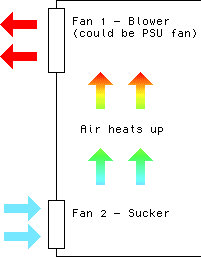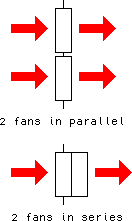The humble fan is the most important cooling component in most computers. Without it,
there'd be little to no air flow through the case. Fans can blow air into the
computer, suck air out, or just move air around inside. The fan on some CPU heatsinks
is a perfect example of the last kind; its sole purpose is to improve the effectiveness
of the heatsink by increasing the airflow over it. These internal fans do nothing to
lower the temperature of the air inside the computer - in fact, they slightly raise
it - but they make that air do more work.
This is only any use, though, if the air is constantly being replaced with cooler
outside air. As the air flowing over a heatsink approaches the temperature of the
heatsink, its cooling efficiency drops. When the temperatures are the same, no
cooling happens at all - you can blow all the 50°C air you like over
a 50°C heatsink and nothing's going to happen.
Standard power supply fans suck air out of the computer and create the familiar warm
breeze out of the back of your miggy. Sucker fans are not what you want next to
your hot components, because the air they move has already passed by other warm bits
of computer, and is thus already warmer. A blower fan, on the other hand, delivers air
from outside the box straight to whatever it's blowing on, and thus does more
cooling for a given size.
In the official ATX (standard PC case) specification, it says that the power supply
fan should blow air into the case, towards the motherboard. Since this guarantees a
steady flow of pre-heated air from the nice toasty PSU, many ATX case manufacturers
ignore the spec and use power supplies with the traditional blow-out fan.
Many cases also have provision for a second fan, usually (in tower configuration cases)
at the bottom front of the case. If you've got a dinky little mini-tower or standard
desktop case with no extra fan mount spot and your Amiga has heat problems, get a better
case. Full stop. Amiga tower cases can be expensive but are worth it in a loaded system,
especially as some machines such as the A4000 have really awful airflow.
Front-of-case fans in most situations have a pretty hard time of it. As far as I know
they arn't very popular in Amiga towers, but are worth mentioning anyway. They're usually
trying to suck air through a fairly narrow vent in the plastic face plate and through
a more-steel-than-holes grille in the front panel. Classier cases often have a dust
filter as well, which lets the air through fairly well when clean but rapidly clogs
to the approximate permeability of a blanket. Add to that the fact that the plastic
cages that hold front-of-case fans practically never actually seal the fan against the
front panel but instead leave it a half-centimetre or so into the case, so lots of air
can leak around the sides, and it's amazing that most front-of-case fans do anything
at all. You can improve the situation somewhat by sealing around your front fan with
cloth-backed Gaffa / duct tape, creating an airtight seal.
If you're feeling more adventurous but don't want to go the whole hog and fit a bigger
fan, you can also cut out the metal in the front fan grille and chop a couple of extra
vent holes in the plastic front panel. This goes for all case fans too, if there is
anything blocking a fan or it's not held against the case itself, you should take steps
to improve it to get better efficeny and less noise.
|
If two case fans are close to each other, they should both blow or both suck. Otherwise
there'll be a storm of cooling air near the fans and not enough air movement elsewhere.
If two fans are located away from each other, though, one should blow and one should
suck, or they'll be trying vainly to change the air pressure inside the case and will
lose a lot of efficiency. You should put the blower (blowing air out of the case) at
the top as hot air rises, and the sucker (sucking cool air into the case) at the
bottom.
A fan will deliver its maximum airflow when it's hanging in space - the so-called
"free air" situation. It will deliver its minimum airflow - zero - when
it's blowing into a sealed box. In the sealed box situation, all the fan can do is move
a bit of air into the box, increasing the air pressure inside, and keep it there. These
two kinds of fan behaviour are governed by the two fan performance statistics - pressure
and airflow.
|

|
All computer fans are roughly the same shape, so their pressure and airflow statistics
are roughly proportional to their size and thickness. Different kinds of air moving
apparatus have different pressure to flow ratios - a "blower", for instance,
which uses an enclosed impeller to push air out of a port, has a higher pressure rating
but lower airflow than a fan of equal power. A hair dryer is a good example of a
blower. It's also possible to buy small 12 volt blowers which can be used in computer
applications, mounted inside the case to direct a well-aimed stream of air at something
that needs cooling, like a CPU.
A computer case is neither a free air nor a sealed box situation. A really well
ventilated case looks to the fan pretty much like the free air situation; the more
tightly buttoned up and packed with cables the case is, the more like a sealed box
it behaves. The crappy mounting locations of many case fans don't really make a lot
of difference to the behaviour of the box, but they reduce the effectiveness of
the fan; a poorly mounted fan behaves like a less powerful one.
|
Arranging fans physically in parallel - next to each other, blowing in the same
direction - gives twice the airflow, but only in the free air situation. The closer
the thing they're blowing into is to a sealed box - the higher the "system
resistance" - the smaller the parallel fan improvement becomes. Any number of
identical parallel fans blowing into a sealed box will do no more than a single
fan.
Arranging fans in series - stacked on top of each other, so one blows straight into
the other - gives the opposite situation. There's no improvement in free-air
performance, but double the pressure increase in a sealed box, and better and better
performance compared to parallel fans as the system resistance gets higher and higher.
Incidentally, this means that those goofy monster processor heatsinks with layered
low-profile fans are a waste of money, since fans strapped onto a heatsink are very
nearly in the free-air situation, and putting two layers of them there does close
to nothing to the airflow.
|

|
So series fans can pump more air into a box with poor through-flow, but parallel
fans will do better in a box with high through-flow. When you arrange one fan blowing
into a computer and another sucking out, you're basically making a poorly sealed
serial fan arrangement. The Amiga's case leaks all over the place, so not all of the air
the blowing fan puts into it exits through the sucking fan, but the arrangement is
much more like serial fans than like parallel ones. This is good; it keeps the airflow
up even in the card-and-cable-packed mess that is many Amigas.
The exact fan arrangement to use therefore varies with the case design, if you’re
going for maximum efficiency. The easy way around the problem is simply to go for overkill,
mount much more powerful fans than you need, and have done with it. As long as the fans
aren't blowing components out of the back of the computer, the problem is solved.
The problems with this solution are that big fans are more expensive, computer power
supplies can be overtaxed by multiple fans (a problem you can solve by using a mains
powered fan, but that's pritty extreem), and big fans make more noise than many users
will tolerate.
Speaking of noise, the noise level of a given fan is usually given in decibels or dB.
dB is a logarithmic scale, so for every three dB the sound level increases you will
hear the sound twice as loudly. Measurements for fans are usually taken in free-air
with a microphone 1m away. The measurement is always taken from the "outside",
so if the fan is a blower it will be in line with the air being blown out, if it's a
sucker it will be on the side where air is sucked into the fan. In real life
situations the location of the fan often has a large effect on it's noise output. If
a fan is facing away from you it will sound quieter. Noise is also made by air being
blown across an object, so depending on how freely air moves thru the fan the noise
level will change. More obstructions equal more noise.
12 volt fans with a three-pin connector plug into the special three-pin headers on
recent PC motherboards and can thus report their rotation speed. This isn't much use on
the Amiga unless you get a fan monitor. Some fans have the three pin plug but only
two wires; they are the same as three wire ones but don't report their speed. Both types
can easily be used on an Amiga if you modify the connector to fit your power supply
connectors. Check what voltage the fan needs first and remember that the white or
black wire is usually ground and the coloured wire is +12V or +5V.
